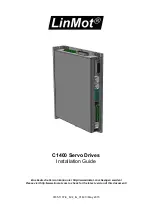
Option 7
- Power save.
Reduces power when servo
are not moving.
Note:
Selecting this option
DISABLES
this feature.
Option 8
- Common cathode
LEDs. Allows common
cathode connection of LEDs
to the outputs.
To calculate the value of
CV9, add up the selected
values. Example: Option 1
and option 3 - CV9 = 1 + 4 =
5
This table will help you determine how to configure the SC82. If there are more than one SC82 or other Gateway capable
devices, only one should have the gateway enabled. In a Digitrax system DO NOT connect the SC82 to the throttle Loconet if
the gateway, DCC control and serial bus are enabled. This could cause an endless sending of switch commands from the track
to Loconet and back to the track.
4.5 Status Report
CV10 - This CV determines which input and output states the SC82 reports (Options 1- 4) when used fore turnout control and
useful only when the serial bus is enabled. This will not work correctly if the servos are configured for mode 2 (3 positions).
This also determines how the LED driver outputs are configured. These options can be enabled in part 3 of Smart
Programming.
Option 1
- Input state messages are sent on the
serial bus at power on. This options is typically
used for inputs that are used for block detection
or turnout feedback. This does NOT apply to
inputs that are used for switch (turnout) control.
Option 2
- Output servo position (state)
messages are sent on the serial bus at power on.
These are switch type messages. Do NOT
enable option 4 at the same time.
Option 3
- Input state messages are sent on the serial bus when a Digitrax interrogation command is received.
Option 4
- Output servo position (state) messages are sent on the serial bus when a Digitrax interrogation command is
received. These are feedback type messages. Do NOT enable option 2 at the same time.
Option 5
- One LED output is used to indicate servo position. This is required if you want to connect two LEDs and a push
button by a 3 wire servo cable to the SC82. A 3 wire interface board is required. See section 6.1.
4.6 Input Control
CV16-39 These CVs determine what action the inputs 1-8 will have when activated. (Inputs 9-16 are used for semaphore
signaling and can not be independently programmed.) There are three CVs for each input. An address, type and transition CV.
See section 7 for CV numbers. If an address greater than 255 is needed then use the address adder. The address adder value
represents a number that is added to the address value to give the ‘actual’ address.
They can each be programmed to operate independently and are not linked or connected to the outputs in any way except by
a common address and type.
In order for an input to cause an action, including executing a route, a transition must be selected. The input is normally at 5
volts. An input transition occurs when the voltage on an input goes from high to low (falling edge) or from low to high (rising
edge). For example, if a push button is connected to an input and ground, when it is pressed the input is grounded. This
causes a high to low transition. When the button is released this causes a low to high transition.
To set addresses for both inputs and outputs see “Smart” Programming for easier programming.
8
System
DCC
Control
Option 6
Gate-
Way
Option 4
Serial
Bus
Option 5
CV
Value
Notes
All DCC
Compatible
Systems
Enabled
0
The SC82 is controlled via the track (DCC
commands).
The bus is not used by the SC82.
Digitrax System
Disabled
Enabled
48
The SC82 is controlled via Loconet.
Digitrax System
Enabled
Enabled Enabled
24
Provides a separate Loconet bus for
Loconet accessory devices.
Allows devices to receive turnout commands
from the track (DCC commands).
Reduces throttle bus traffic.
NCE System
and others
Enabled
Enabled
Enabled
24
Provides separate bus for bus enabled
accessory devices.
Allows devices to receive turnout commands
from the track (DCC commands)
Status Report
Value
Select
No options
0
Option 1 - Send input state at power on enabled
1
Option 2 - Send output state at power on enabled
2
Option 3 - Interrogate input state enabled
4
Option 4 - Interrogate output state enabled
8
Option 5 - Use 1 LED output instead of 2 to indicate servo position
16
Status Report values total


































